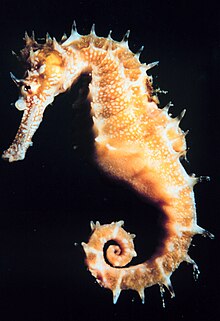Sea horse
| Seahorses Temporal range: Lower Miocene to present – 23–0 Ma |
|
|---|---|
 |
|
| Hippocampus sp. | |
| Scientific classification | |
| Kingdom: | Animalia |
| Phylum: | Chordata |
| Class: | Actinopterygii |
| Order: | Syngnathiformes |
| Family: | Syngnathidae |
| Subfamily: | Hippocampinae |
| Genus: |
Hippocampus Rafinesque, 1810 |
| Species | |
|
see Species. |
|
see Species.
Seahorse is the name given to 54 species of small marine fishes in the genus Hippocampus. "Hippocampus" comes from the Ancient Greek word hippos meaning "horse" and kampos meaning "sea monster". The word "seahorse" can also be written as two separate words (sea horse), or hyphenated (sea-horse). Having a head and neck suggestive of a horse, seahorses also feature segmented bony armour, an upright posture and a curled prehensile tail.
Seahorses are mainly found in shallow tropical and temperate waters throughout the world, from about 45°S to 45°N and live in sheltered areas such as seagrass beds, estuaries, coral reefs, or mangroves. Four species are found in Pacific waters from North America to South America. In the Atlantic, H. erectus ranges from Nova Scotia to Uruguay. H. zosterae, known as the dwarf seahorse, is found in the Bahamas.
Colonies have been found in European waters such as the Thames Estuary.
Three species live in the Mediterranean Sea: H. guttulatus (the long-snouted seahorse), H. hippocampus (the short-snouted seahorse), and H. fuscus (the sea pony). These species form territories; males stay within 1 m2 (11 sq ft) of habitat, while females range about one hundred times that.
...
Wikipedia
